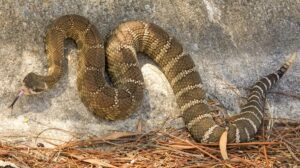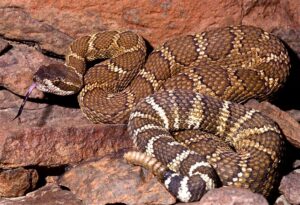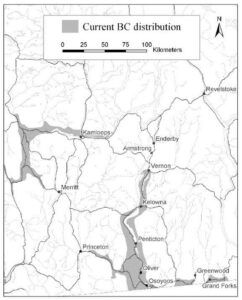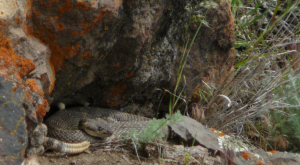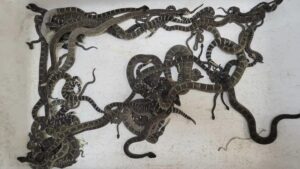Northern Pacific Rattlesnake (Crotalus oreganus)
Updated on
25/04/2024The northern Pacific rattlesnake is a highly venomous pit viper species of North America. The medium-sized snake is usually active at dawn and dusk and is nocturnal in the hot summer months. It may come out occasionally during the day to bask on rocks but is hidden in crevices for most of the day.
Scientific Classifications
- Suborder:Serpentes
- Family:Viperidae
- Genus:Crotalus
- Species:C. oreganus
Conservation Status
Description
Size
The size of the species varies significantly, with some having stunted growth and others growing very big. The mainland specimens often reach 39 in (100 cm) in length with the maximum recorded length being 64 in (162.6 cm).
Color and Appearance
The ground color may be gold, bronze, or different shades of pink, tan, or gray. The color of the iris often matches the ground color. There are dark brown blotches on the dorsal side of the body, with each being surrounded by a lighter color. They have a flat, triangular head, wider than the neck, and a rattle at the end of their tails.
The juveniles have nearly distinct patterns that fade as the creature ages.
Are They Dangerous to Humans
The northern Pacific rattlesnake is not aggressive when encountered. It either flees in an attempt to escape or freezes to divert attention from it. When molested or attacked, it tries to defend itself by taking a coiled position, rattling its tail as a warning sign. It also holds its head high to observe its attacker.
It is reluctant to bite people, and its venom is only for killing its prey. Even if it bites, 30-40% of the time, it is a dry bite (with no venom injected). But its venom can be potentially dangerous. So, a bite from this snake warrants immediate medical attention. Although death from its bite is rare, excruciating pain and suffering (like muscle breakdown, blood clotting, limb function loss, flaccid paralysis, seizures, coma, and severe shock) are common effects observed in almost all hospitalizations.
Northern Pacific Rattlesnakes at a Glance
Distribution
It lives in western North America from the Baja California Peninsula to the southern interior of British Columbia.
Habitat
Preferring drier habitats, the snake lives in grasslands, prairies, brush, and sometimes in forests, woods, rock ledges, caves, and along streams. It avoids deserts.
Lifespan
It lives for 10-15 years in the wild and 15-20 years in captivity.
Predators
It is eaten by hawks, owls, eagles, bobcats, and coyotes.
Diet
It uses its heat-sensing facial pits to locate its prey of bird eggs, birds, small reptiles, amphibians, and small mammals, from mice to rabbits. The juveniles eat insects.
Reproduction
Viviparous (gives birth to live young)
They mate in spring after emerging from winter dormancy. It usually occurs in hidden areas like burrows, crevices of logs and rocks, or dense brush. However, the British Columbia population mates in the fall before the onset of dormancy.
The females pass through a gestation period of around 90 days when they undergo fasting. They give birth in August or September, with the neonates being 19-28 cm (average 25.2 cm) in total length. A typical litter comprises of 1-15 (3-8 on average) young.
Source
ithoughthecamewithyou.com, oregonencyclopedia.org, researchgate.net, cloudfront.net, tampabay.com

